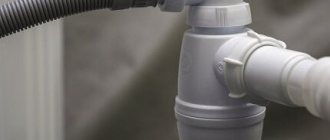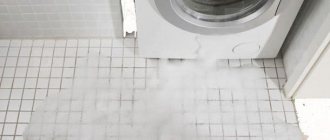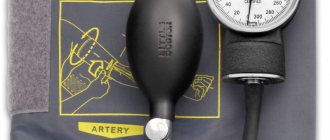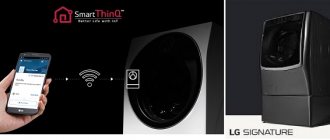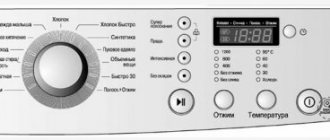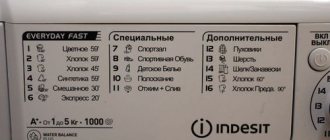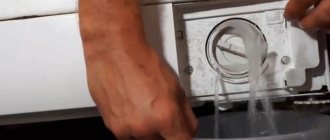The washing machine has made caring for clothes much easier. After putting dirty things in it, after a while you can take out absolutely clean ones. However, after washing, clothes also need to be dried. For this purpose, a balcony is traditionally used, on which rows of ropes are stretched, or special room dryers. But manufacturers of household appliances have long figured out how to improve the drying process by releasing special drying machines.
True, this technique is not very popular yet. Many still consider it an unnecessary luxury. Whether you need a dryer is, of course, up to you. But you will agree that the ability to dry clothes immediately after washing has many advantages. Firstly, your balcony will finally be free of decoration in the form of ropes and wet clothes, and you can calmly spend time there without fear of getting your washed clothes dirty. Secondly, you don’t have to wait several hours for your clothes to dry. Thirdly, dust from the street does not settle on it and unpleasant odors, for example, from cigarettes that my beloved husband smoked on the balcony while clothes were drying there, are not absorbed. Many models of dryers can even relieve the owner of the need to iron clothes - they can be immediately put in the closet.
A dryer is especially necessary for families with small children, where they have to wash and dry a large amount of laundry every day. Our mothers and grandmothers hung wet rompers over the stove to dry them quickly, but we can optimize this process by using a dryer. Some models can disinfect clothes with steam, which is very important for children's clothes.
The dryer can also be used for other purposes. For example, to refresh everyday clothes if there is no need to wash them. The device can clean soft toys that accumulate large amounts of dust, fluff pillows, or gently dry shoes.
How does this miracle of technology work and what should you pay attention to first when buying a dryer? You can learn about this and much more from our article.
How do dryers work?
Most dryers look similar to washing machines. They have almost the same body, control panel, hatch and drum. The hatch can be either with or without glass (completely plastic).
The dryer drum has a very large volume (from 80 liters) to dry a sufficient amount of laundry at a time. You can load up to 8-9 kg of wet clothes into them. If you have a washing machine with a load of 5-6 kg, choose a dryer with the maximum capacity to dry all the washed clothes at once. Keep in mind that wet clothes are heavier than dry ones.
The dryer does not need to spin the drum very much, so its speed rarely exceeds 100 rpm. The principle of operation of a drying machine is the same as that of a washing machine, only in it, instead of water, the laundry is treated with heated air. Evaporating moisture condenses and is removed in different ways, which we will discuss below.
Modern dryers have several programs for drying clothes. With intensive drying, it is dried in less than an hour with very hot air, but some fabrics may shrink after this. A gentle regime is intended for them, which takes much longer.
The Iron On program leaves items slightly damp, making them easier to iron. By turning on the “Into the closet” mode, you will receive completely dry clothes that can be immediately stored. Timed drying is used when clothes only need to be dried a little. When you turn on the “By fabric type” mode, the machine automatically sets the required time and temperature depending on the type of material.
Types of dryers
In the domestic market of household appliances, the range of drying machines is represented by drum-type devices, cabinets, and washing machines with a drying function. Let's look at each variety in more detail.
Types of dryers
Drums
This type of dryer looks like a classic front-loading washing machine. By rotating, the drum allows you to process the laundry with hot air as evenly as possible. The result of such exposure is low (no more than 5%) residual moisture content of the laundry. Moisture removal can be done in two ways.
Condensation
Evaporated moisture condenses on the surface of the heat exchanger, collects in a special container or is discharged directly into the sewer. The dried air is heated again and supplied to the working space of the machine.
Advantages:
- Compactness;
- Easy to install.
The disadvantage is the higher cost than that of exhaust type units.
Ventilation type dryers
Moisture, along with the air flow, enters directly into the ventilation system. Air intake for work can be carried out in different ways: from the room or through the supply air duct directly from the environment.
Advantages:
- Simplicity of design;
- Relatively low cost.
The main disadvantage is the need to connect to an exhaust duct.
Drying cabinets
The drying cabinet is a heat-insulated metal structure with compartments for storing outerwear, linen, shoes and hats.
Drying cabinet
It should be understood that the internal contents may vary significantly depending on the model and manufacturer of the device.
The cabinet is equipped with a heating element, an exhaust fan, and an automatic system responsible for adjusting and maintaining certain drying parameters. Moisture is removed through a ventilation system with an air duct or a condensation system with a water collection tank.
Advantages:
- Can be used for drying and storing things;
- Large capacity;
- Possibility of simultaneous drying of clothes, shoes, hats.
The disadvantage is the rather impressive dimensions and weight of the device.
Washer-dryer
Choosing the best dryer for your home is impossible without considering a washing machine with a clothes drying function. Such models are a kind of hybrid of a washing machine and a dryer. The heating element installed behind the drum heats the air, which is supplied to the textiles by a blower fan. Rotation of the drum makes it possible to dry the laundry as evenly as possible.
Washer-dryer
Advantages:
- Multifunctionality;
- Ease of operation;
- Possibility of adjusting the humidity percentage.
Flaws:
- Impossibility of high-quality drying of the entire load of laundry;
- Uneconomical.
Drying types
There are the following types of drying machines - drum dryers and drying cabinets. We described the operating principle of a drum dryer in the previous section. These devices are the most popular because they do not take up much space in the apartment. They can be installed next to the washing machine or on it (in a column) using special fasteners. Most often, both devices are purchased from the same manufacturer.
There are other types of dryers that are not so popular. These are drying cabinets. They are quite large: height 175 cm, width and depth 60-65 cm. But you can dry only 3-4 kg of laundry in such a cabinet. Its main advantage is that clothes are hung on hangers, as in a regular closet, and in this position they are blown with warm air. It is not deformed and is not damaged due to friction against the drum. In the closet you can safely dry items made from delicate fabrics, underwear, hats, and shoes.
Based on the principle of moisture removal, dryers are divided into three types - ventilating, condensing and heat pump. Ventilated dryers are cheaper, but you should consider the principle of removing moisture. The fact is that moist air must escape from them. The hose of the device is most often connected to the ventilation system or the water is discharged out the window, which is not very convenient. These restrictions determine the low demand for such devices.
Dryers with Heat Pump technology are much more convenient, but much more expensive. They do not exhaust humid air outside, but pass it through a heat pump. There, moisture condenses and is removed, and the air is heated and reused.
Thanks to the closed heat exchange system, such drying is very economical. There is practically no heat loss, so such a device can save its owner up to 50% of electricity compared to other dryers. But purchasing it will cost much more.
The most popular are condensing dryers, so we will talk about them separately.
Tip 3: Heat pump dryer to save energy
Heat Pump Models: Energy Efficient, but Expensive
Modern and energy efficient, but more expensive to purchase, heat pump dryers represent the next evolution of condensing machines. Starting from 25 thousand rubles. devices become available that heat the air entering the machine, which passes through the evaporator, where moisture condenses, and the dry air again enters the pump and is heated.
The advantage of the technology is that, compared to a ventilation machine, there is virtually no heat loss. Thus, this type of machine can save the owner up to 50% of the electricity consumed by a “conventional” condenser dryer. At the same time, initially purchasing such a machine is more expensive, and maintenance will have to be performed more often due to the more complex mechanism. In addition, such a device will require more time to dry one batch of laundry than other types of dryers.
What are condenser dryers?
A condenser dryer is slightly more expensive than a ventilated dryer, but it consumes less electricity. With condensation drying, moisture is not removed outside. The moist air heated by the heating element is cooled in the heat exchanger. The resulting condensate enters a special container, from which it is then simply poured out. Sometimes they are connected directly to the sewer system so as not to remove the water manually.
The advantage of condensation dryers is that they can be installed anywhere without being tied to a ventilation or sewage system. Almost all models are equipped with special filters for fibers and lint; this part purifies the air, improving its circulation inside the device. It is advisable to clean the filter after each dryer operation cycle. This extends the life of the motor and improves the quality of operation of the equipment.
What is a clothes dryer
The main function of a clothes dryer is to dry textiles in a short time. Equipment Features:
- You can control the work process using an electronic panel or touch keys.
- A small backlit indicator will reflect the time and process of operation of the equipment.
- The machine has different functions - based on the principle of residual moisture, super-drying and classification according to the type of textile product.
- The average dimensions of the device in width and height are 70 by 60 with a depth of 42 cm. However, they can vary from smaller to larger parameters.
- Equipment differs in energy consumption classes, most often they are B and C, less often - A.
Principle of operation
The design of such a machine is interesting. The body is made of metal. Things are loaded inside the dryer through a hatch or metal door. The dimensions and the possibility of reversing the door allow you to put the car in any place. Some compact models have special filters that perform dust collection functions. They need to be changed frequently. There is a requirement not to place the machine between the washing machine and the bedside table.
This machine looks and feels like a washing machine inside and out. However, there is a significant difference between them - the size of the drums. It is larger in the dryer; more space is needed to process laundry. The average drum capacity is 100 liters. It is designed for up to 8 kg of laundry. Things are dried by blowing a stream of warm air. The maximum temperature of thermal influence is 70 degrees. The maximum drum rotation speed is 100 revolutions per minute.
Kinds
The kit will include a clothes dryer, instructions for use/connection and all the necessary elements for this. Pay attention to the parameters of the device, and before purchasing, measure the place where the unit will stand. The following is a rating of popular models that are offered for sale in Moscow and St. Petersburg. You can compare prices and choose the best dryer for yourself:
- drum or cabinet;
- combined with a washing machine or separate.
Capacity
The capacity of the dryer depends on its dimensions and the volume of the drum. If you are purchasing a dryer in addition to your washing machine, be sure to find a place to install it, as both units are usually the same size. The depth of the dryer is 60-65 cm, the width is about 60 cm, and the height is 85 cm.
Compact dryers with more modest dimensions are also available for sale. However, it should be borne in mind that they are equipped with a smaller set of functions and will be able to dry a small amount of laundry at a time. They should only be chosen if you are forced to choose saving space over functionality.
The optimal drum volume is from 100 liters. This machine allows you to load 5-6 kg of laundry. When loading, keep in mind that there must be enough free space inside the drum for normal circulation of heated air. Then the clothes will not bunch up into one big lump, but rather will smooth out.
When choosing a dryer, be guided by the capacity of your washing machine and the frequency of use of the device. If you turn it on less than 4 times a week, a load of 4-6 kg will be enough. When using up to 6 times a week, choose a model with a capacity of at least 7 kg. You can easily dry even large items in it.
If you dry laundry daily and in larger quantities, including large items, we recommend choosing a dryer with a capacity of 9 kg. It will simplify your task as much as possible.
Many buyers ask the question: why buy a freestanding dryer when there are washers with a drying function? Is it worth overpaying? When purchasing “2 in 1” devices, the following point should be taken into account. When loading the drum, for example, 5 kg, they can dry a maximum of half of the washed items at a time. That is, the drying program will have to be run twice, which leads to excessive energy consumption. And you can load all the washed clothes into the dryer at once, because its drum allows you to do this.
ASKO TDC112C
Another option for a modern dryer is from the manufacturer ASKO, for example, model TDC112C:
- Price: 69,000 rub.
- Characteristics: manufacturer – Slovenia; type – condensing; control – rotary switch; installation on a washing machine is prohibited; maximum load – 7 kg; number of programs – 8; drum volume – 112 l; display type – no; progress and time indicator; protection from children; energy consumption group – B.
- Pros: there is drum lighting; display in several languages; sound accompaniment at the end of work; mode adjustment.
- Cons: noisy; knitted items are tightened.
- Psychology of family relationships
- Ceftriaxone - instructions for use for injections
- How to avoid troubles on holiday in Turkey: tips for tourists
Power consumption
The issue of electricity consumption by a dryer worries all users, because the device operates for quite a long time. More electricity is spent on heating air than heating water, so the first dryers were very “gluttonous”. Several years ago, it was very difficult to find a device in a store with at least energy efficiency class B. Most often we came across devices marked C and even D.
Those who have heard about energy efficiency classes of household appliances know that there are seven in total, and they are designated by Latin letters from A to E. The higher the class, the more money you will save on operating the appliance.
Nowadays, many manufacturers produce dryers with energy efficiency class A. They are more expensive than those marked B or C, but they will soon recoup the money spent on them by reducing energy consumption.
When purchasing, you should also take into account the power consumption of the equipment. The higher it is, the faster the laundry will dry and the less money you will spend on electricity. But keep in mind that there are models on the market with a power of up to 4 kW. The wiring in not every apartment can withstand such a load. Therefore, before purchasing, it is recommended to consult an experienced electrician and possibly replace the wires. But the best option is still considered to be devices with a power of 2 kW.
How to choose a dryer
Having decided on the type of car, you can go further and delve into the technical characteristics. Let's start with the download type.
Dryers come with front or vertical loading. The former are represented by a large number of models, so there is plenty to choose from. The latter can be used in small rooms, because... they do not require “extra” area to open the door.
The time you spend drying depends on the volume of the drum and the weight of the load. This is especially true for families with children, where they have to wash and dry almost every day.
The drum volume for models with horizontal (front) loading is usually 100-120 liters, while for “vertical” models the volume is only 80 liters. The capacity of the “dryer” is selected based on the volume of the washing machine drum. It needs to be larger because the clothes in the dryer need to move freely inside the drum. As for weight, the most popular models are machines with a load of 7–9 kg.
Attention is also paid to other characteristics of the drum. The area of application depends on the speed of its rotation, because each fabric has its own speed. For example, wool, cotton and silk need to be dried at low speed. Synthetics and denim are fine for larger ones.
The presence of reverse (rotation in different directions) also increases the drying speed and prevents creasing. For delicate processing of things, it is worth choosing models with a honeycomb drum. Its internal cavity has a characteristic relief reminiscent of a honeycomb.
Controls in drying machines are:
- mechanical - using rotating pointer handles;
- electronic - using buttons;
- touch, when commands are entered through the touch display;
- combined - combines several types of control.
Management does not affect the service life and ease of use - these are network myths. Think for yourself, is it more difficult to turn a knob than to press keys?
The type of control is chosen more by the manufacturer than by the buyer. Some dryers can be exclusively touch controlled due to their advanced functionality and a large number of modes, which cannot be configured using buttons.
To save on electricity bills, you will have to spend money on a high-end energy consumption dryer. It is designated by Latin letters from A to G. The lowest class is G, the highest is A. The higher the class, the more economical the car. Manufacturers mainly produce models of classes , , A++, A+++ and .
It remains to decide on the dimensions. If you have a lot of space, you can take a full-size car. Its standard dimensions are: width 60-70 cm, depth 60-64 cm, height 84-90 cm. If the seats are “butt-to-end”, you need to take a narrow model with a depth of 47-55 cm.
For those who need to strictly save space, and can only install a dryer instead of a washing machine, a clever way has been invented to install 2 machines in a column. The idea is that one car is placed on top of the second using a special mounting kit. This way you can fit both a washer and a dryer into a limited area!
Installation of dryers
The installation of a dryer largely depends on its operating principle. Ventilation models should be placed close to the hood, while condensation models can be installed anywhere. If desired, they can be connected to the sewer system.
There are also several ways to place the device indoors, each of which has its own characteristics. The dryer can be placed on top of the washing machine, next to it, in a special niche or under the countertop.
The first option is the most popular. This method is called column installation. It is especially relevant for small apartments, as it allows you to save precious space. To install devices in a column, special fasteners are required. If they are not included with the equipment, they must be purchased separately.
Installing a dryer above a washing machine without fasteners is strictly prohibited. During operation, the device vibrates strongly, so it can easily slip.
Column installation is quite simple. Fasteners and special caps are installed on the body of the washing machine. Then the dryer body is attached to the caps, the legs are unscrewed, and the device is leveled. Sometimes equipment is attached to the wall using special slats, but this option is used very rarely. An important point is that the washing machine should not be narrower than the dryer, otherwise the stability of the structure will be in question.
If you plan to purchase a dryer during the renovation, you can make a special niche for it from plasterboard or even a cabinet for mounting in a column. If the drying machine is installed alone in a niche, you can place a shelf for linen on top of it.
The last option is installation under the sink and countertop. It is used if all household appliances in the apartment are built-in. This placement makes it easier to connect the device to communications and saves space in the kitchen.
After installing the dryer in the chosen way, it must be connected to communications - a ventilation shaft or sewerage system and to electricity.
Connection to ventilation is made through a flexible air duct, which is connected to the ventilation hole of the device. The second end of the pipe is led out into the central ventilation duct or into the window.
If you purchased a condenser type dryer, you can manually empty the water from the container or make your life easier by connecting the device to the sewer. To do this, it has a special drain hole to which you need to attach a regular drain hose. It is discharged either directly into the drain, or into the sink or toilet.
Lastly, the equipment is connected to the electrical network. To do this, you can draw a separate line from the distribution box or use a socket, which must be grounded. The electrical network servicing the dryer must be protected by an RCD and a circuit breaker.
Types of dryers
According to the method of loading and placing laundry, they are distinguished:
- Drying cabinet , in which things are hung on hangers and ventilated shelves. It is convenient for outerwear and allows you to load more items. The main disadvantage of cabinets is their size. This is a bulky appliance, more suitable for use in laundries than in apartments.
- Drum dryers , which are visually indistinguishable from washing machines. Laundry is also loaded from the front. This technique is more compact; there are even very small-sized models.
- Automatic dryers operating on the principle of an electric battery can be identified as a separate subtype . The laundry is hung on rods, inside of which there are heating elements. Using the control panel, you can adjust the temperature, turn on the backlight, raise and lower the bars. The most common dryers of this type are manufactured by Alcona.
Depending on the type of drying, machines are divided into:
- Ventilation , the principle of operation of which is based on the removal of moisture directly into the ventilation. A significant disadvantage of such models is the risk of moisture retention in the pipe, box or shaft. Warm, humid air quickly leads to the growth and reproduction of fungus, which can be hazardous to health.
- Condensation , in which hot air first evaporates moisture from the laundry, and then moves along a cooling circuit, where the steam again turns into water. The condensate reservoir can be easily emptied manually or directly discharged into the sewer system. The undoubted advantage of such models is their ease of installation. It does not require additional air ducts. However, more expensive models are equipped with an additional heat pump. Thanks to the improvement, hot steam releases heat at the moment of condensation, and the machine uses it to heat the air.
